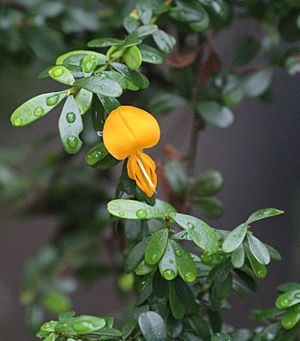Espino de sabana facts for kids
Quick facts for kids Espino de sabana |
|
|---|---|
 |
|
| Scientific classification | |
| Genus: |
Brya
|
| Species: |
ebenus
|
| Synonyms | |
|
Aspalathus ebenus L. |
|
Brya ebenus, also known as espino de sabana, granadillo, cocus wood, and coccuswood, is a type of flowering tree. It belongs to the pea family, called Fabaceae. This tree naturally grows on the Caribbean islands of Cuba and Jamaica. In gardening, it is often called the Jamaica(n) rain tree.
Contents
What the Jamaican Rain Tree Looks Like
The Jamaican rain tree is a small tree that can handle dry weather well. It usually grows to be about 20 to 30 feet (6 to 9 meters) tall. This tree has long branches that hang down.
Its leaves are small and waxy. They are usually made of 2 or 3 smaller parts, but they often look like single leaves. Many leaves grow close together in a zig-zag pattern on short stems.
The tree produces bright yellow flowers. These flowers grow in small clusters. Like many plants in the pea family, the flowers look like peas. They have both male and female parts and are symmetrical.
After flowering, the tree grows fruits called legumes. These are like pea pods and are typical for the Fabaceae family.
Where the Jamaican Rain Tree Grows and Lives
Brya ebenus grows in dry, open areas called scrublands. It needs a lot of sunlight to grow well. The tree blooms with flowers throughout the year, but not always at the same time.
As its common name suggests, the Jamaican rain tree is famous for blooming right after it rains. This might help the tree make seeds quickly when rain is not common. Its bright flowers attract insects like bees, which help pollinate the tree.
Like many plants in the pea family, the Jamaican rain tree has special bacteria in its roots. These bacteria help the tree take nitrogen from the air and turn it into food. This allows the tree to grow even in poor soils.
How People Use the Jamaican Rain Tree
People grow Brya ebenus for several reasons. It is used as a beautiful ornamental plant in gardens. It is also popular for making bonsai trees, which are small, carefully shaped trees.
The wood from this tree, called cocus wood, is very valuable. It is a very hard and dense hardwood. Cocus wood is known for its excellent sound quality. In the 1800s, it was often used to make flutes in England and France. Today, it is still sometimes used for wooden musical instruments. These include bagpipes, clarinets, oboes, and piccolos.
See also
 In Spanish: Brya ebenus para niños
In Spanish: Brya ebenus para niños

